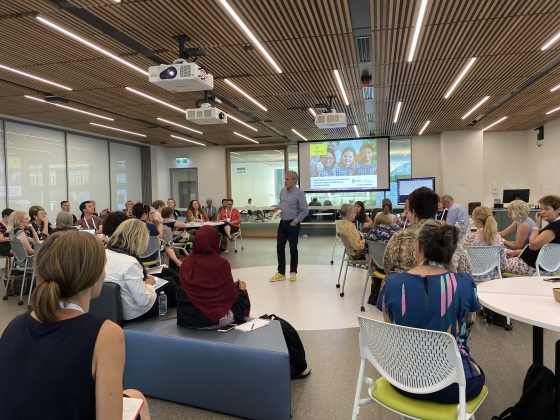Context: Editorial for TinHE. Starts with comment about 'Rhodes Must Fall' movement in South Africa (2015) - focusing on globalised system that is "increasingly characterized by inequality" (p.361). Special issue = focused on socially just curriculum reform, with a shared "concern about the ways in which curricula are deeply implicated in the processes of producing and reproducing inequality" (p.361)
Editors draw on Fraser's notion of 'parity of participation' and mis/recognition
Miller (2016) = brings instrumentalist drivers for curriculum reform into foreground - with calls for inter-disciplinary research to 'solve' big problems glossing over epistemic tensions
Anwaruddin (2016) focuses on role of curriculum in relation to inequality in Second Language Teaching Education
Hordern (2016) = recontextualisation can lead to misleading knowledge values
Coleman (2016) = recontextualisation of academic knowledge/ literacies from professional context and into curriculum
Winberg et al. (2016) - looks at engineering curricula and epistemological flows/ semantic waves
Luckett et al (2016)= uses post-colonial theory to examine entry to privileged/white university in South Africa
Abbas et al. (2016) = examines societal transformative potential of curriculum and pedagogy, particularly through acquisition of disciplinary knowledge
Clegg (2016) = looks at what reframing curriculum could look like/ do (social realist perspective)
-
A socially just curriculum reform agenda
Date: 2016
Author: Shay, S.; Peseta, T.
Location: South Africa
Annotation links:
addView Annotation
-
A Strong Foundation: Inclusive Education at an Australian University College
Date: 2012
Author: Cocks, T.; Stokes, J.
Location: Australia
Annotation links:
addView Annotation
-
A study of the difficulties of cares and support in new university teachers' work
Date: 2006
Author: Walker, C.; Gleaves, A.; Grey, J.
Location: United Kingdom
Annotation links:
addView Annotation
-
A temporal approach to higher education research
Date: 2014
Author: Ylijoki, O.
Annotation links:
addView Annotation
-
A typology for a social justice approach to assessment: learning from universal design and culturally sustaining pedagogy
Date: 2018
Author: Hanesworth, P.; Bracken, S.; Elkington, S.
Location: United Kingdom
Annotation links:
addView Annotation
-
A Value Beyond Money? Assessing the Impact of Equity Scholarships: From Access to Success
Date: 2014
Author: Reed, R.; Hurd, B.
Location: Australia
Annotation links:
addView Annotation
-
A Wraparound Approach to 'Whole of Student' Issues: Education, Health, and Community Services - Review of Literature Project Report
Themes:
lensWraparound Models -
A Wraparound Approach to ‘Whole of Student’ Issues: Education, Health, and Community Services
Themes:
lensResearch GrantlensWraparound ModelsaddView Annotation
-
AARE Symposium: Research Initiatives for Equity and Equality in Australian Schools
addView Annotation
-
Abridged too Far? Credit Transfer: Examining the Transition Process from TAFE to University,
Date: 2013
Author: Millman, T.
Location: Australia
Annotation links:
addView Annotation
-
Academic and Social Integration in Higher Education: a survey of satisfaction and dissatisfaction within a first-year education studies cohort at a new university
Date: 2004
Author: Rhodes, C.; Nevill, A.
Location: United Kingdom
Annotation links:
addView Annotation
-
Academic identities in contemporary higher education: sustaining identities that value teaching
Date: 2019
Author: McCune, V.
Location: United Kingdom
Annotation links:
addView Annotation
-
Academic involvement in Outreach: Best practice case studies from health and languages
Date: 2016
Author: Harris, P.; Ridealgh, K.
Location: United Kingdom
Annotation links:
addView Annotation
-
Academic mothers finding rhyme and reason
Date: 2009
Author: Pillay, V.
Location: South Africa
Annotation links:
addView Annotation
-
Academic pedagogies, quality logics and performative universities: evaluating teaching and what students want
Date: 2009
Author: Blackmore, J.
Location: Australia
Annotation links:
addView Annotation
-
Academic tutors at the frontline of student support in a cohort of students succeeding in higher education
Date: 2009
Author: Walsh, C.; Larsen, C.; Parry, D.
Location: United Kingdom
Annotation links:
addView Annotation
-
Accepting employability as a purpose of higher education? Academics perceptions and practices
Date: 2019
Author: Sin, C.; Tavares, O.; Amaral, A.
Location: Portugal
Annotation links:
addView Annotation
-
Access and Barriers to Online Education for People with Disabilities
Date: 2016
Author: Kent, M.
Location: Australia
Annotation links:
addView Annotation
